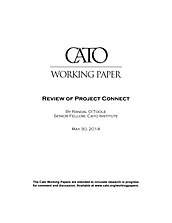Project Connect — a planning consortium sponsored by the City of Austin, Capital Metro, the Capital Area Metropolitan Planning Organization, and Lone Star Rail — proposes to build a 9.5‑mile, high-capacity transit line in Austin from East Riverside & Grove to Austin Community College’s Highland campus. Transit vehicles would follow a dedicated guideway — either rails or an exclusive busway — with trains or buses stopping about every one-half mile. Although buses are being considered as an alternative, it is clear that Project Connect planners already favor rail; as a presentation by Project Connect concludes: “Urban Rail is the appropriate mode to meet system needs.“1
There are several problems with this proposal. First, the proposed rail line is not truly highcapacity transit; though Project Connect has failed to admit it, buses can actually move more people than light rail. While light rail can move about 9,000 people per hour — most of them standing — double-decker buses on city streets can potentially move 18,000 people per hour — most of them comfortably seated.
Second, the line is projected to cost $1.38 billion, but planners have failed to demonstrate the need for an expensive, dedicated guideway system of either bus or rail. In fact, the peak-hour demand projected for the line is well below the capacity of either buses or light rail. Austinites make more than six million person trips per day, of which the light-rail line would carry less than a third of a percent. Yet constructing the light-rail line would consume 5 percent of the region’s transportation budget for the next 25 years, and operations and maintenance would increase the cost still further. By comparison, express lanes now under construction on the MoPac freeway cost one-seventh as much as the light rail yet are expected to significantly reduce congestion and move four times as many people per day.
Finally, project planners have greatly overestimated the benefits of the proposed line. Far from relieving congestion, light rail will make it worse as it will have priority at traffic signals, disrupting the flow of traffic for everyone else. Far from providing people with speedy travel, its speeds will average no more than 22 miles per hour and, more likely, less than 18 miles per hour. Far from providing clean transportation, light rail will require fossil fuels to generate the electricity it needs; power plants for Dallas’ light-rail system use more energy and emit more carbon dioxide per passenger mile than the average sport-utility vehicle. Far from promoting economic development, light rail is liable to slow it down as the taxes required to support it will discourage businesses from moving to Austin.
For much less than the cost of a single fixed-guideway transit line serving a few travelers, Austin can both improve bus service and relieve traffic congestion for all travelers. Traffic signal coordination, staggered bus stops in high-demand areas, increased bus frequencies, double-decker buses on high-demand routes, and the construction of more HOT lanes will smooth traffic flows and provide better transportation for everyone in the Austin area.
Notes:
1 Project Connect, Presentation to Central Corridor Advisory Group, Meeting #12, May 2, 2014, slide 25.

